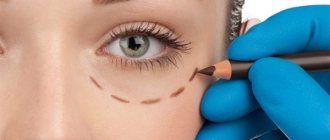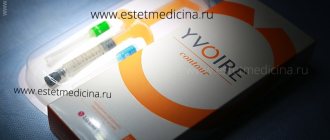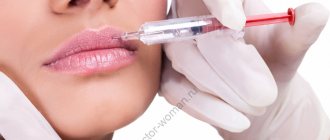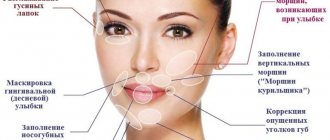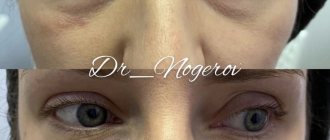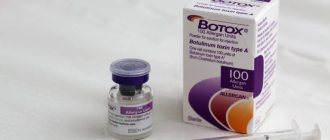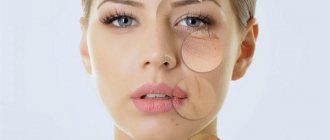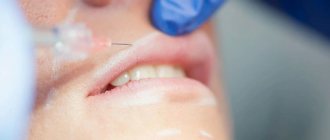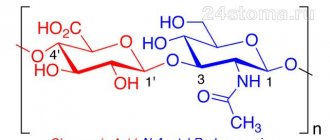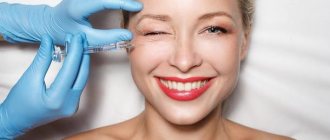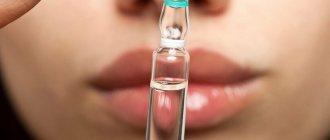The basis of gels for facial contouring is hyaluronic acid. It is found in human skin cells, retaining moisture, maintaining volume, providing elasticity and a healthy color, but with age, the synthesis of hyaluronic acid noticeably decreases.
Facial contouring with hyaluronic acid fillers is safe. Their biological compatibility with tissues is high, and over time the body eliminates the drugs naturally.
The gel is injected using a needle or cannula intradermally, subcutaneously or into the periosteal layer. The main task is to change the volume of tissue at the injection site. If the drug is injected into the wrinkle area, the defect is filled. Also in this place, metabolic processes improve, the active synthesis of collagen fibers and elastin is resumed. As a result, the skin becomes hydrated, elastic and smooth again.
Preparation for the procedure
Before contouring, a consultation with a doctor is required, during which the following aspects are discussed:
- Patient expectations;
- History - has the client ever resorted to contouring, and if so, what medications were used;
- Features of the upcoming technique and, as a result, the possibility of achieving the desired result;
- Presence of contraindications;
- Selecting the required one or more drugs.
The day before injections with hyaluronic acid fillers, you must refrain from drinking alcohol and heavy physical activity.
Progress of the procedure
Facial contouring with hyaluronic acid should be performed by qualified specialists in a clinical setting, since this procedure requires not only knowledge of anatomy and masterly technique, but also sterile conditions. GMTClinic doctors perform all types of correction and will also help correct the unsuccessful result of contouring.
The features of the procedure depend on the area of influence, the desired effect and the individual characteristics of the patient. Therefore, you must first sign up for an initial consultation with a doctor, during which indications, contraindications and choice of drug are discussed.
The duration of the procedure itself and the number of injections are determined depending on the tasks facing the cosmetologist. One injection with preparation and correction of the filler injection area takes 10 minutes or more. The duration depends on the volume of work and the individual approach to each patient.
The following stages of facial contouring with hyaluronic acid are distinguished:
- The skin is cleaned and disinfected using a disinfectant solution;
- The doctor marks the areas where the drug will be administered;
- A local anesthetic is used at the site of the intended impact to reduce discomfort from injections (if the gel contains the anesthetic lidocaine, additional anesthesia is usually not required);
- The drug is injected using a syringe, after which a special ointment is applied to soothe irritated skin.
- After a few days, you need to visit a cosmetologist for an examination for possible correction.
Contour plastic surgery with fillers for the correction of lacrimal and palpebromalar grooves has long been used in their practice by cosmetologists. Professional analysis of the patient’s anatomical features (presence and presence of lower eyelid hernias) is an indispensable condition for successful injection blepharoplasty. I would like to share with my colleagues my own classification, in which I distinguish three clinical types of the lower eyelid zone, which takes these changes into account.
How can this classification be used in practice to obtain the optimal result of periorbital contouring and minimize the risk of adverse events?
Contour plasty of the lacrimal and palpebromalar grooves is carried out both with a needle and with a blunt cannula, and this procedure gives a good aesthetic effect. However, sometimes delayed adverse events may appear: accumulation of filler below the tear trough, visual enlargement of lower eyelid hernias, increased swelling in the periorbital area. To prevent such adverse events, it is important to take into account the anatomical characteristics of each individual, paying close attention to the presence and severity of lower eyelid hernias.
Doctors at our medical center perform contour plastic surgery with fillers using my proposed clinical classification of the lower eyelid area, and this facilitates the selection of patients for contour plastic surgery of the periorbital area.
Clinical types of the lower eyelid area
The classification distinguishes three clinical types of the lower eyelid zone, depending on the presence and severity of hernias:
type 1 – lack of volume in the lower eyelid area; type 2 – the presence of hernias in the medial part of the orbit and visualization of the bony edge of the orbit in the lateral part; type 3 - hernias are visible in both the medial and lateral parts of the orbit.
Three types of changes in the lower eyelid area
Three types of changes in the lower eyelid area
For patients with the 2nd, and especially the 3rd clinical type of the lower eyelid zone, we advise solving the problem with the help of a plastic surgeon. If there are contraindications to surgical intervention, injection camouflage of hernias is possible; in this case, we use fillers based on hyaluronic acid.
It should be taken into account that the target space where the filler will be injected depends on the anatomical features of the periorbital region, that is, on the clinical type of the lower eyelid area. After injecting the filler, to reduce the risk of undesirable consequences, the drug must enter exactly the target space, regardless of what instrument the doctor uses - a needle or a cannula. In all cases, augmentation with fillers of the periorbital region - the level of drug administration is axillary (on the periosteum).
Before the procedure, it is necessary to mark dangerous zones to prevent their injury: the zone of the angular vessels (the inner corner of the eye and a centimeter lateral to it) and the zone of the infraorbital foramen (it is found by palpation). We recommend avoiding injections into hazardous areas.
a – diagram of type 1 lower eyelid zone augmentation using a needle. Dangerous zones are marked in red, the boundaries of the injection zone are marked with a black dotted line, and the projection of filler boluses is white; b – diagram of augmentation of the type 1 lower eyelid area using a cannula.
Patient with clinical type 1 of the lower eyelid zone: a – before; b – 2 weeks after augmentation.
Correction of the lower eyelid zone type 1
Clinical type 1 is associated with a lack of volume throughout the lower eyelid area (more often found in young patients who complain of blue discoloration under the eyes).
When correcting a type 1 zone, hyaluronic acid filler should be injected under the orbicularis oculi muscle into the space bounded superiorly (cranially) by the septum and inferiorly (caudally) by the orbital retinaculum ligament (ORL). Injection of the drug below the ORL ligament may lead to its accumulation below the tear trough in the long term.
The landmarks between which injections will be made are: the projection of the bony edge of the orbit (upper border) and the eyelid-buccal junction (lower border).
When using a needle, a bolus technique is used to introduce fillers or a microbolus fan between the upper and lower boundaries with preliminary marking of dangerous zones.
The drug is also administered using a cannula between the boundaries described above. The preferred cannula insertion point is at the level of the lateral canthus between the projection of the bony edge of the orbit and the eyelid-buccal junction (lateral eyelid approach). When using the buccal approach, in some cases the cannula does not pass through the ORL, but moves it away. As a result, augmentation of the tear trough area with a cannula from a buccal approach gives a good immediate aesthetic effect, but subsequently can lead to accumulation of the drug below the tear trough.
a – diagram of augmentation of the lower eyelid zone of the 2nd type using a needle; b – diagram of augmentation of the lower eyelid zone of the 2nd type using a cannula.
Patient with clinical type 2 of the lower eyelid zone: a – before; b – 2 weeks after augmentation.
Correction of the lower eyelid zone type 2
This type presents with lower eyelid hernias visible in the medial part of the orbit. At the same time, the bony edge of the lateral part of the orbit is visualized. Thus, in the medial part of the lower eyelid there is excess volume in the form of a hernia, and in the lateral part there is a lack of volume.
Injecting the drug into a hernia is associated with the risk of infectious complications and undesirable consequences, in particular, long-term swelling may appear after fillers and an increase in the volume of the hernia. And this must be avoided.
When correcting the type 2 lower eyelid area, the drug should be injected submuscularly, in the medial part below (caudal) the tear trough to prevent it from entering directly into the hernia, and in the lateral part – between the projections of the bony edge of the orbit and the eyelid-buccal junction.
When using a cannula, the medial part is augmented from the buccal approach, and the lateral part is augmented from the lateral eyelid approach.
a – diagram of augmentation of the lower eyelid zone of the 3rd type using a needle; b – diagram of augmentation of the lower eyelid zone of the 3rd type using a cannula.
Patient with clinical type 3 of the lower eyelid zone: a – before; b – 2 weeks after augmentation.
Correction of the lower eyelid zone type 3
In this case, hernias are noticeable in both the medial and lateral parts of the orbit. As already mentioned, injection of filler into the hernial tissue is unacceptable. Therefore, when correcting the lower eyelid area of this type, filler is injected only caudal to the lacrimal and palpebromalar grooves. The level of drug administration is submuscular. Either a needle or a cannula can be used (buccal access). Incomplete correction is recommended to avoid the effect of a puffy face (pillow face).
To correct the type 3 lower eyelid area, we recommend using flexible dermal fillers of medium reticulation.
Conclusions The anatomical features of each patient, including the presence and severity of lower eyelid hernias, must be taken into account to obtain the optimal result of contouring of the periorbital zone. Correction of the lower eyelid area, taking into account the principles outlined in this article, gives a good aesthetic effect with a low risk of undesirable consequences. If the level and target area of augmentation is observed, post-procedure swelling is minimal or absent, and the effect after fillers lasts for more than a year.
Anna Reznik, dermatologist, cosmetologist, chief. doctor at the ARclinic medical center, certified trainer for contouring and botulinum therapy from IPSEN, St. Petersburg
Effect of the procedure
The whole procedure takes on average 30-40 minutes. Of these, 20-30 minutes are occupied by anesthesia of the injection zone with an anesthetic cream, which includes one or more anesthetics (lidocaine, ultracaine, procaine).
Microneedles are used for injections, leaving no traces.
The effect of the procedure is noticeable immediately.
After the procedure, slight bruising and swelling may appear, which will disappear in a few days, and then the effect will become even more obvious.
The aesthetic result depends on the initial objectives:
- Small wrinkles disappear, deep creases and folds are smoothed out.
- Facial features take on the desired shape. The lips become fuller, the chin becomes larger (important for men), the bridge of the nose is straightened, etc.
- The effect of age-related ptosis (tissue drooping) is eliminated.
- Visible signs of skin rejuvenation appear.
The final result of filler injection can be assessed 1-2 weeks after the procedure, when the drug is finally distributed in the tissues.
If necessary, the result of the procedure can be corrected by introducing an additional dose of filler, or reducing its volume by introducing enzymes that hydrolyze hyaluronic acid.
To ensure that the drug is distributed evenly and does not undergo fragmented degeneration, after the procedure you should not sunbathe, visit the bathhouse or solarium for two weeks. It is also recommended to exclude sports activities for three days and refuse massage. You can use decorative cosmetics the very next day.
Repeated facial skin contouring with fillers is indicated after the drug has been absorbed. The speed of this process depends on the characteristics of the gel, the area being corrected, and the individual characteristics of the body.
Preparations for contouring
The list of fillers that can transform your appearance is quite extensive. New ones are constantly appearing, but it is important that the drug has a certificate and is approved by the FDA and Roszdravnadzor, confirming its safety and quality.
GMTClinic uses classic fillers from the best foreign manufacturing companies:
- Juvederm (France) - hyaluronic acid gels containing lidocaine for a painless procedure. Juvederm Volift and Juvederm Volume can correct nasolabial folds, correct the shape of the cheekbones and chin. To fill severe wrinkles and correct the shape of the nose, GMTClinic specialists choose Juvederm Ultra. Juvederm Smile gels are suitable for lip augmentation.
- Restylane (Sweden) - fillers from this manufacturer were among the first to be used in cosmetology. Gel fillers “Restylane”, “Restylane Vital”, “Restylane Perline” and “Restylane Sub-Q” have proven themselves in excellent reviews and are used for procedures in various areas, including the skin of the neck and décolleté.
- Belotero (Germany) - this line of the German company MertzFarma is represented in GMTClinic by gels with lidocaine Belotero Soft and Belotero Balance. While the first drug fills facial wrinkles well and refreshes the skin, the second is injected into the cheekbone area to make it possible to restore lost tissue volumes, as well as eliminate scars and correct wrinkles of varying depths.
- Revaness Pure (Canada) - the filler provides a long-lasting effect due to its longer retention in the skin. It copes well with both expression lines and more pronounced wrinkles. It is used to smooth out nasolabial folds, enlarge lips, and add volume to cheekbones.
- Radiesse (USA) - drugs from this manufacturer are intended to correct skin changes associated with insufficient tone and hydration. A good effect is achieved by filling sagging, flabby tissue in the chin and cheek area. According to numerous reviews, it removes scars well.
- Yvoire (Korea) - new generation gels from the manufacturer LGScience. The series consists of three fillers: Yvoire Hydro, Yvoire Classic and Yvoire Volume. The drugs vary in viscosity and are injected into the skin at different depth levels. Due to the special structure of the drugs, the results of their use are noticeable over a longer period of time.
- ReDexis (Canada) - high-tech skin rejuvenation in different areas of the body. Together with hyaluronic acid, the drug contains special microspheres that attract substances to the injection site for the synthesis of its own collagen. The skin is renewed and remains fresh and tight for a long time.
- Etermis (Russia - Germany) - two types of hyaluronic acid allow you to quickly restore skin hydration and take care of volume. The composition also includes mannitol, which prolongs the lifting effect. For small wrinkles, use Etermis 3, and for pronounced wrinkles, use the denser Etermis 4 gel.
- Novacutan FBio (France) - a unique formula ensures uniform distribution of filler in tissues, preventing movement. The line consists of three drugs: Light, Medium and Volume. They differ in density and are used in various areas of the face: from the nasolacrimal groove to the chin.
- Neauvia (Nyuvia) (Italy) - preparations of ultra-pure hyaluronic acid. GMTClini uses the following fillers from this line: INTENSE FLUX (for delicate areas in the eye area, etc.), STIMULATE (for correcting deep folds) and STIMULATE MAN, designed taking into account the characteristics of men's skin.
- Endoret Gel (Spain) - the drug is obtained using a special technology using the patient’s own blood. After administration, the gel starts the process of skin renewal, slowing down aging at the cellular level. Allows you to eliminate wrinkles of varying depths in the eyes, lips and chin.
- AestheFill (South Korea) is a powerful stimulator of collagen production. Ball-shaped microspheres actively interact with skin cells, helping to smooth out wrinkles and create new tissue. The quality of the skin noticeably improves, and the effect lasts up to two years.
- Sculptra (Sculptra) (USA) - this filler is made on the basis of polylactic acid, which makes its use possible even in those patients who do not want to use hyaluronic acid. An excellent result for severe signs of aging is achieved by stimulating collagen synthesis, filling lost volumes and moisturizing the skin, with a gradual increase in effect, and lasts up to two or more years.
Indications
- Presence of age-related changes and/or wrinkles, furrows;
- “Floated”, asymmetrical oval face;
- Wrinkles in the eyelid area and corners of the eyes;
- Nasolabial folds of different depths;
- Changing the shape of the nose, restoring the volume of the cheekbones and chin;
- Elimination of asymmetry, changing the shape/volume of lips;
- Decreased skin tone, enlarged pores;
- Skin defects (atrophic scars, including stretch marks, post-acne);
- Various types of atrophy of facial and body tissues.
Filler injection technique
In the area of nasolabial folds, fillers are introduced mainly using two techniques: linear and fan. The needle is inserted into the deep layer of the dermis, positioned parallel to the surface of the skin, the filler is injected at the moment when the doctor slowly pulls out the needle. Thus, the filler is evenly distributed in the skin crease area, straightening it from the inside. The upper parts of the nasolabial folds are filled using the fan technique. If the nasolabial folds in the upper part of the wings of the nose are very deep, then the bolus technique is used. The doctors of our cosmetology clinic Code Beauty Medicine in Dolgoprudny master all injection techniques and use a needle or cannula to reduce tissue trauma.
Make an appointment
by phone +7 (985) 228-44-55
via whatsapp
Benefits of contouring
- Safety. Hyaluronic acid gels are biologically inert preparations of non-animal origin that do not cause allergic reactions and are absolutely compatible with the tissues of the human body;
- The result of aesthetic correction made with gel fillers is visible immediately;
- The rejuvenation effect after contouring is as natural as possible;
- The procedure does not require anesthesia, unlike plastic surgery;
- No scars or marks on the skin;
- A large amount of work can be done in one contouring procedure - for example, increasing the volume of the lips, eliminating deep wrinkles and emphasizing the cheekbones;
- There is no rehabilitation period. Slight swelling is possible for 2-3 days;
- The result lasts up to 12-18 months, and the use of some drugs helps to extend it up to three to four years.
Cost of correction of nasolabial folds
| Service | Volume | Price |
| Surgiderm | 0.8 ml | 13950rub |
| Juvederm Ultra2 | 0.55 ml | 10300rub |
| Juvederm Ultra3 | 1 ml | 14950rub |
| Juvederm Ultra4 | 1 ml | 15500rub |
| Belotero Soft | 1 ml | 12500rub |
| Belotero Balance | 1 ml | 13650rub |
| Belotero Intense | 1 ml | 14800rub |
| Hyaluform Soft | 0.8 ml | 10300rub |
| Hyaluform Normal | 1 ml | 12500rub |
| Hyaluform Deep | 0.8 ml | 13500rub |
Anesthesia | ||
| Cream "Akriol Pro" | 30 min | 500r |
| Artikain | 5 minutes | 500r |
5% discount when paying for two fillers. 10% discount when paying for 3 or more fillers.
Make an appointment
by calling +7 (985) 228-44-55
via whatsapp
Correction of nasolabial folds before and after photos
Photos of patients before and after the contouring procedure (doctor N.A. Solovykh)
Fillers correction of nasolabial folds before and after photos (doctor N.A. Solovykh)
Photos of patients before and after the contouring procedure (doctor N.A. Solovykh)
Photos of patients before and after the contouring procedure (doctor N.A. Solovykh)
Correction of nasolabial folds with fillers, doctor N.A. Solovykh
Smoothing of nasolabial folds with fillers, doctor Ratnikova S.V.
Smoothing of nasolabial folds with fillers, doctor Ratnikova S.V.
Fillers correction of nasolabial folds photos Before and After (doctor Guseinadzhieva M.Z.)
Correction of nasolabial folds with fillers (doctor Ratnikova S.V.)
Correction of nasolabial folds with fillers (doctor Almazova A.A.)
Correction of nasolabial folds with fillers (doctor Almazova A.A.)
Correction of nasolabial folds with fillers (doctor Almazova A.A.)
